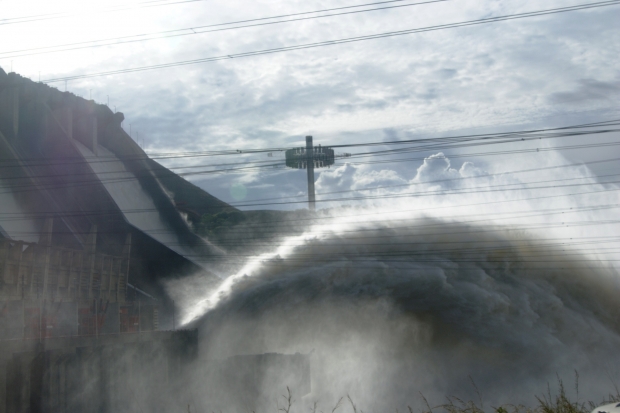Drought: Hydropower's Achilles Heel

Drought: The news has been full of it.
Fish are disappearing from markets from Zimbabwe to Vietnam because of it. Kenyan barristas are making "camelcinos" because drought has made cow milk scarce. And in India, men from some villages are even finding it hard to get wives because the water shortage makes them look like a bad bet.
Across Asia, Africa and Latin America, the rains are not falling – they’re failing.
Drought has always happened; the climate is naturally variable to some degree. But researchers have long predicted that climate change would increase the extremes and frequency of drought, and the evidence suggests this is happening now.
But drought is no longer just a concern for farmers; it’s increasingly becoming a major humanitarian and political issue, particularly in hydropower-dependent countries.
Not So Renewable
Long considered a renewable (which is a subject of hot debate) and regarded as less variable than wind and solar, hydropower is now looking distinctly vulnerable as reservoirs dry up and electricity generation drops.
This year, Venezuela extended the length of the Easter holiday – because of the weather. Water levels behind Guri Dam, which provides half the country’s electricity, hit record lows. Now the government has shortened the work week to four days through May, in an effort to prevent rolling blackouts.
Halfway across the world, in Zambia, they’ve been battling major blackouts as the water levels behind Kariba Dam drop. The country receives the vast majority of its power from dams, but water levels behind the dam are currently at just 16% of capacity.
The India Times reported earlier this year that electricity supplies across India will be vulnerable to disruption through the summer as severe heat waves – already in full swing – sweep the country. Over four-fifths of large hydro reservoirs have lower water levels than in 2015, and hydroelectric power generation has dropped at least 15% in the last year – despite the fact that more projects have come online.
The country has reason to be nervous – in 2012 India experienced the world’s worst rolling blackout, which left an astonishing 670 million people in the dark. (That's more than the populations of the US, Canada, Mexico and Japan combined.) Though India’s only 20% hydro-dependent, the outage was blamed, in part, on a low-rainfall monsoon season that reduced hydropower generation.
This isn’t just a problem in the developing world. Hoover Dam has seen such catastrophically low water levels that engineers are installing turbines at a lower elevation to prepare for future shortages. In a Slate article last year, Pacific Institute’s Peter Gleick broke down hydropower's risky future: “In a world in which the climate is changing, the value of hydro becomes more uncertain,” he told Slate. “We know that one of the worst impacts of climate change will be impacts on water—on droughts, on floods, on demand [via increased evaporation].”
Drought is hitting hydropower-dependent countries hard. And these countries are often among the world’s poorest – some 14 of the 17 world’s poorest countries rely primarily on hydropower for electricity.
When electricity supplies hit a shortage, prices surge upwards – a boon, perhaps, for utilities, but a terrible burden for many consumers. Rolling blackouts lead to economic losses, and this has major repercussions across society. People can’t keep their shops open; they lose produce and refrigerated goods. They can’t study at night.
Industry suffers as well, with plants reducing hours and laying off workers who can ill afford a pay cut. Drought can ultimately lead to political instability: In Colombia, which relies on hydropower for 70% of its electricity, drought-related energy shortages forced the country’s mines minister, Tomas Gonzalez, to resign his position earlier this year.
And, as we’ve seen illustrated dramatically in the last year, economic instability and political turmoil can lead to increased migration – a can of worms Europe is currently struggling with.
Time to Diversify?
The World Bank and others still tout hydropower as the fastest and easiest way to meet carbon reductions targets. But building large hydro is neither fast, nor cheap, nor easy. And when a hydroelectric plant breaks down, countries are often forced to fall back on older, more polluting generation options to fill the gap. In Tasmania, a long-shuttered gas plant was recently brought back online as an emergency measure. The climate is losing out in this equation.
The costs of wind and solar have fallen dramatically in the past five years, and their installation is skyrocketing across the globe. Countries like Germany have proven that it’s possible to safely integrate wind and solar into the grid in large quantities. There is no excuse for ignoring these energy options.
Drought will be a political issue – and a major driver of political turmoil and migration – for decades to come, thanks to climate change. Where we can mitigate climate change’s impacts, we can and we must.
For hydropower-dependent countries, moving away from hydropower will one important way to improve economic stability. It’s high time they diversified their energy mix into wind and solar. Otherwise the already devastating scenarios we’re already witnessing will seem like child’s play.




